
Here in the eastern United States, we love our hummingbird. I say that in the singular as we only have one species regularly found in the East. Occasionally a couple western species drop in, but not regularly like the Ruby-throated Hummingbird drawn to our feeders.
In Ecuador, birders have recorded 132 species of hummingbirds. On this trip, our leader made sure we found the Antpittas and the hummingbirds. We would find 67 species of hummingbirds. Because almost all of them were drawn to feeders, I caught nice images of 47 species. Like the Antpittas, the place to find hummingbirds were places with feeders and not just one or two feeders but banks of feeders that attracted dozens of hummingbirds.
The hummingbirds were often very comfortable around us.
Ecuador, where the Andes Mountains slice right down the middle of the country, has an elevation range from sea level to 20,549 feet in a country just 409 miles wide at its widest point. It is a very vertical and linear country. Compare that to South Carolina with the highest elevation 3,560 feet and a state that is 273 miles at its widest. Like with the Antpittas, we found some hummingbird species widespread, and most species were concentrated in specific elevation zones. Each stop provided new birds to find. Some species would be seen at many stations, while others we would only find once.
With the huge array of hummingbirds, we would find some quite plain and others stunningly beautiful. Some were big and some tiny. Some are aggressive and others docile. One species we found, and I was unable to photograph, was the Giant Hummingbird. Well named, this hummingbird clocks in about the same size as an American Robin. We only saw it in one area high up in the Andes Mountains. We never saw a Giant Hummingbird at a feeder.
Wrestling with how to present this huge array of birds, I decided to focus on their names and to primarily provide images with some text. In the text, I am trying to highlight how common or rare the species were and the way elevation dictates the presence or absence of many species. This elevation dependence is why the bird species is so diverse in Ecuador! I will use the abbreviation of FASL for Feet Above Sea Level. Feel free to scan the images and read about those that attract your attention as there are a lot of images!
When there are so many species, someone needed to decide on the common names. It would be boring if they were all called hummingbirds. I noticed some “themes” in the creative names and will present my images in clusters based around those themes.
Of the 47 species of hummingbirds, I got images of only 5 birds called hummingbirds.

Sword-billed Hummingbird – This, like the Giant Hummingbird, was a highly desirable sighting. We marveled at how this bird could spear that bill into the small port of a hummingbird feeder or a flower. A higher elevation species (7,500 to 9,000 FASL), we would only see it at one location!
Many-spotted Hummingbird – Well named, this bird prefers the east side of the Andes and an elevation of 1,800 FASL but can be found between 1.200 and 3,500 FASL. We would only see it once.
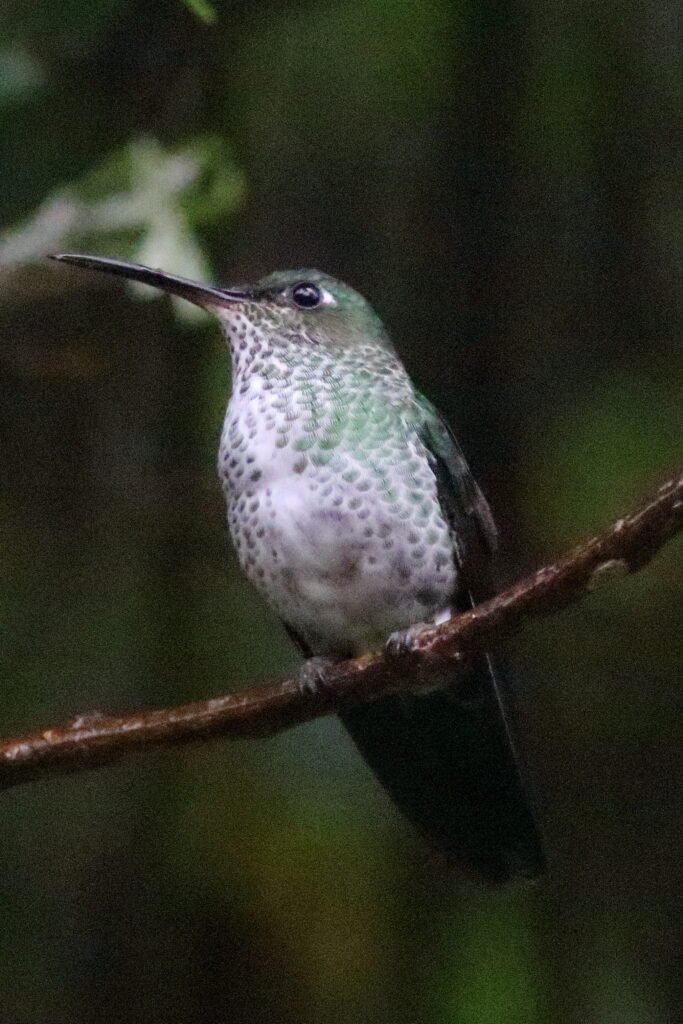

Speckled Hummingbird – In Ecuador, this bird frequents both the east and west side of the Andes. It preferred elevation ranges from 3,000 to 7,500 FASL. As a result, we saw these on five occasions.
Purple-chested Hummingbird – We only saw this bird twice and each time it was a single individual. This species’ range only touches the NW corner of Ecuador, so I felt lucky to capture a picture!
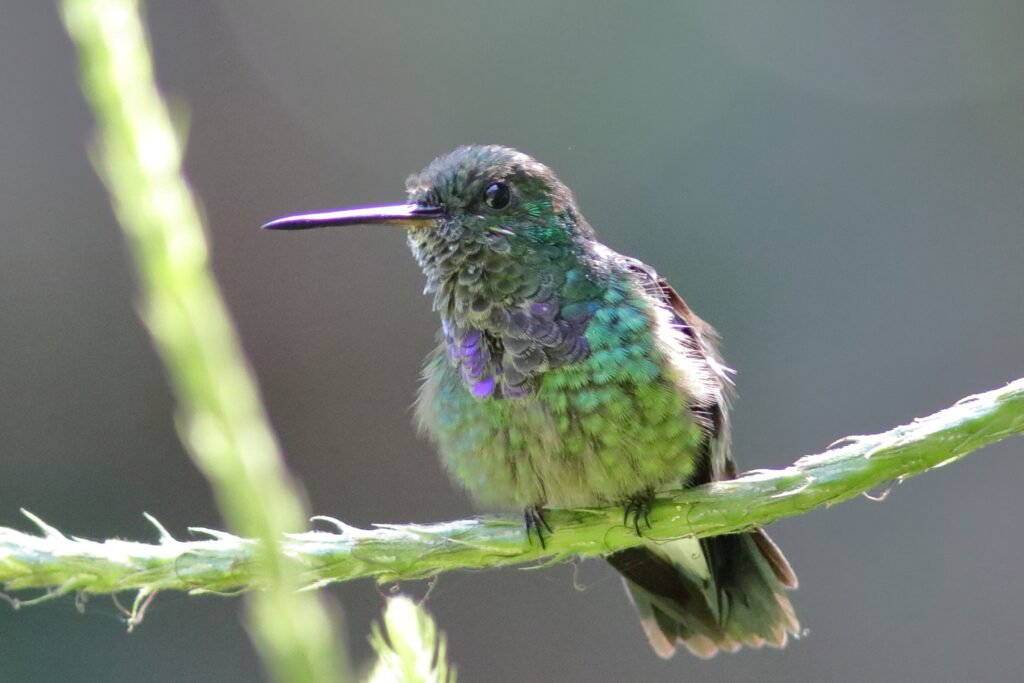

Violet-bellied Hummingbird – This species differs from the previous by how the purple extends lower on the body. We only found a single one of these once and it was at the same location as one of the Purple-chested Hummingbird.
Rufous-tailed Hummingbird – A highly aggressive hummingbird found on the western slope of the Andes; we would find this distinctive bird at 6 locations. It was at the hotel in downtown Quito where we would spend six days over the whole vacation, so we had numerous opportunities to see it there. Its rufous tail and red bill made it easy to identify.
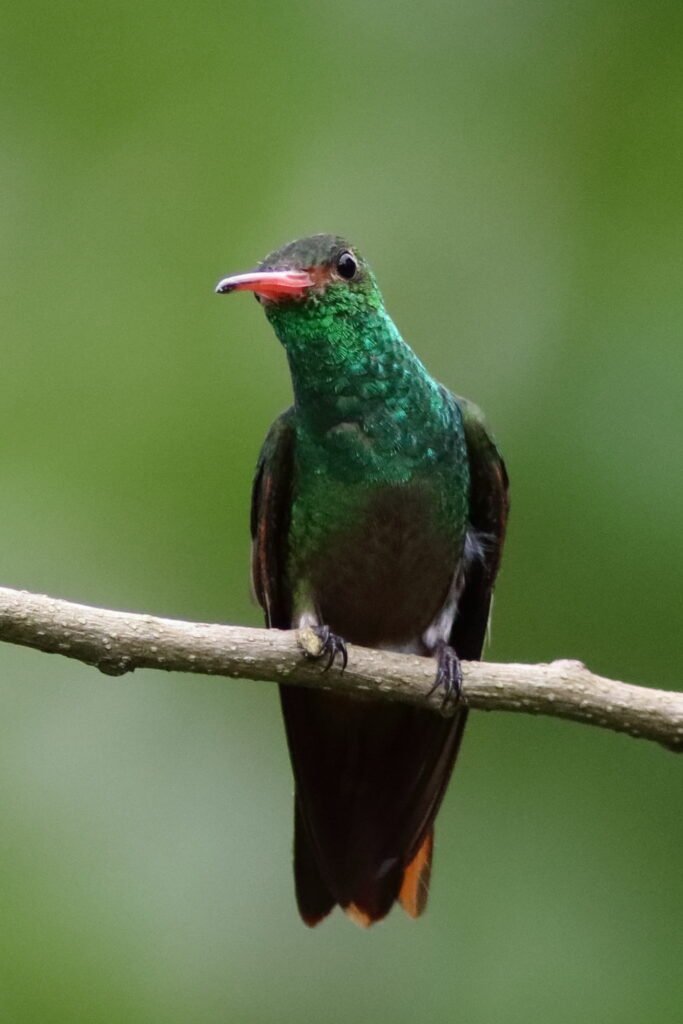
Another set of hummingbirds carry the name Brilliant. They fit their name. The Brilliants we found included:
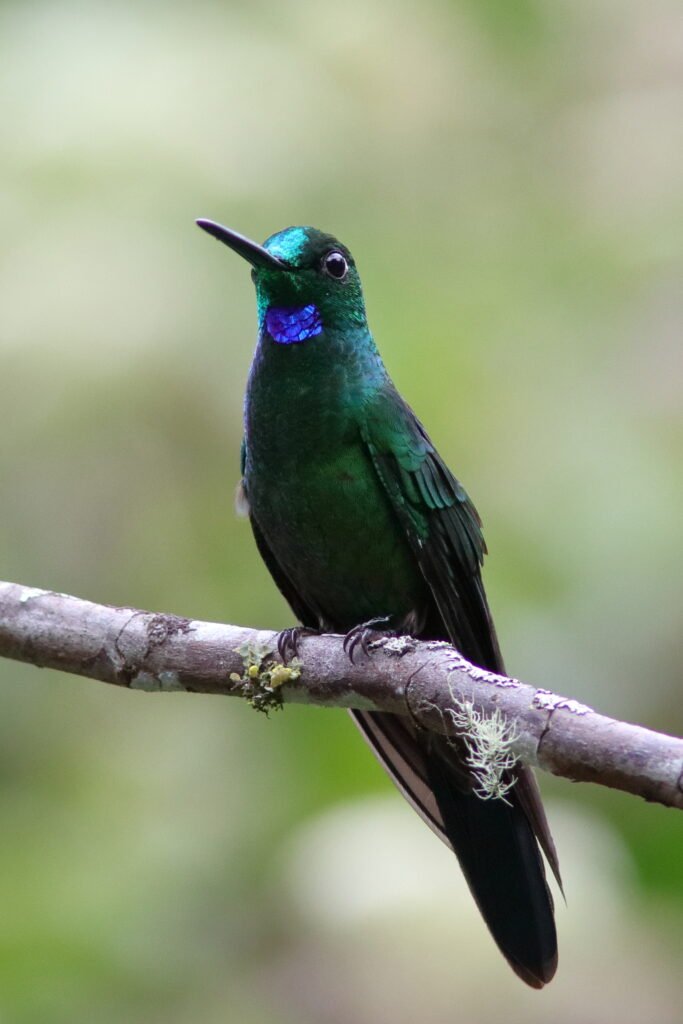
Green-crowned Brilliant – This plain, though brilliant green hummingbird we found 4 times all on the west side of the Andes Mountains.
Violet-fronted Brilliant – In Ecuador found only on the east side of the Andes, this bird only appeared at two feeding stations. Only the male has the violet crown.


Fawn-breasted Brilliant – This species is fairly unique in how it can be found on both sides of the Andes Mountains. Since it is found only between 3,300 FASL and 6,300 FASL, the tall Andes Mountains creates a barrier. More and more scientists have decided that two such disjunct populations eventually evolves into two separate species. Since the two population never come in contact, maybe someday this will evolve into two species. We found them four times in fairly large numbers on the west side, but just a single bird on the east.
A coronet is a small crown. The group of hummingbirds have bright head colors or crowns. We found three of them.
Buff-tailed Coronet – The field mark for this species is the buff tail. We would see them on both slopes and in nice numbers.


Chestnut-breasted Coronet – Despite being a coronet, the best field mark is the chestnut breast. We found this species on the east slope of the Andes. They liked the high altitudes of 4,800 to 7,100 FASL.
Velvet-purple Coronet – This large hummingbird lives up to the coronet moniker with its bright purple head. In Ecuador, it can be found only in the NW corner. We would see it at 3 locations.
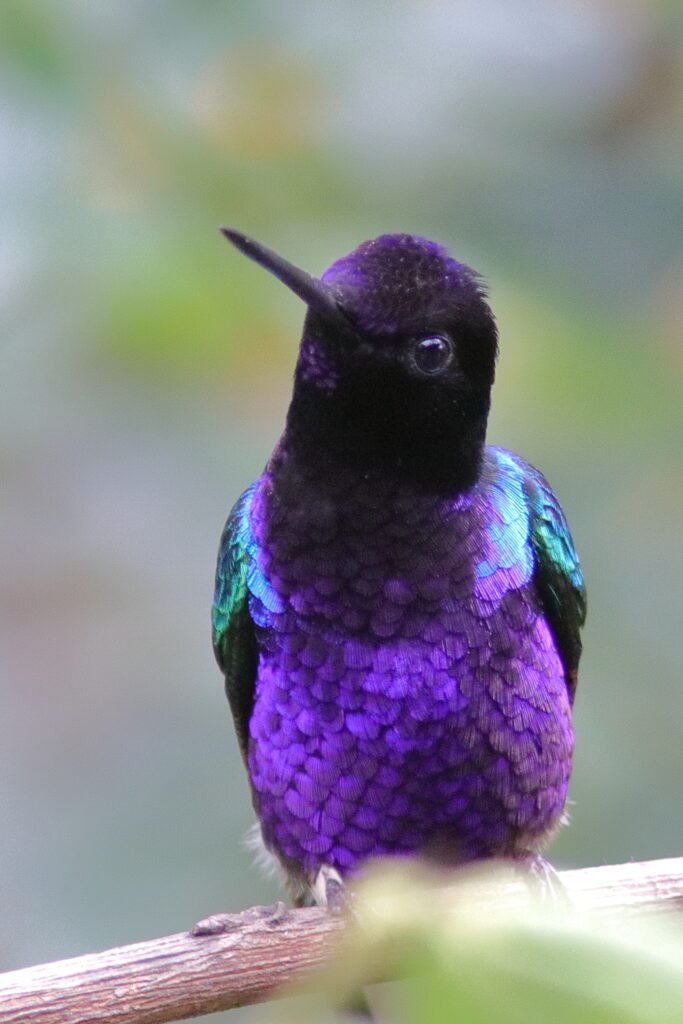
Other hummingbirds get names of jewels like emeralds or sapphire, which is fitting.

Andean Emerald – In Columbia, one can find this species on both sides of the Andes. In Ecuador, they are mostly on the west side. In Peru they are only on the east side. Your guess is as good as mine as to why. We found them at the Alambi Reserve and the Refugio Paz de las Aves (the place that first trained the Giant Antpitta to come to a feeder).
Western Emerald – The Western Emerald tolerates cities and can often be found in city gardens. The only place we would see this was the hotel San Jose de Puembo in Quito where we would return between the various legs of our adventure.
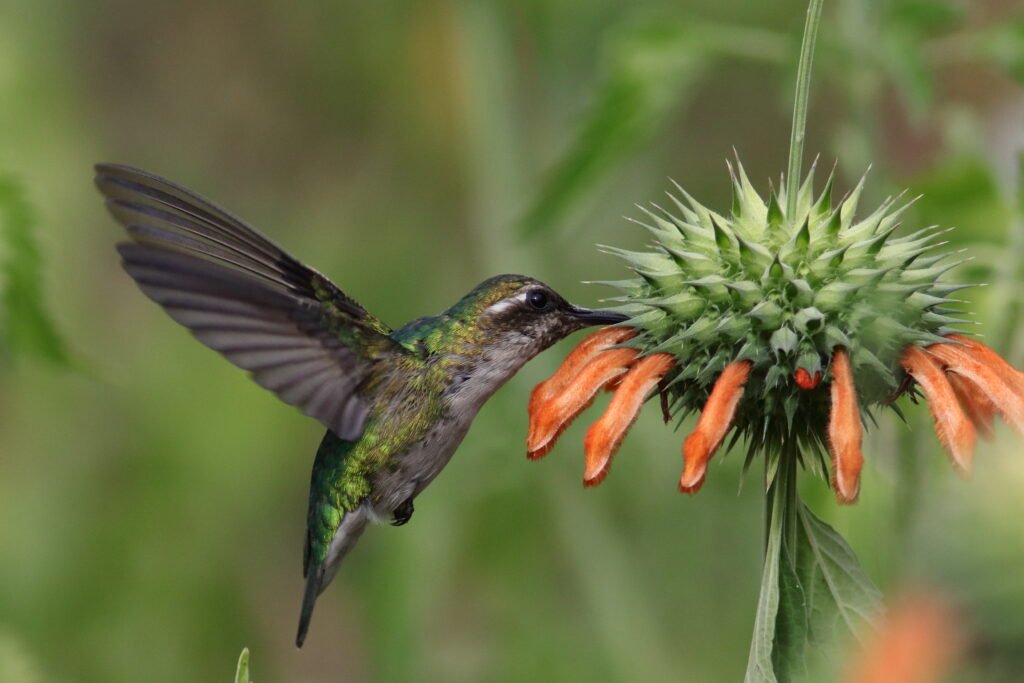
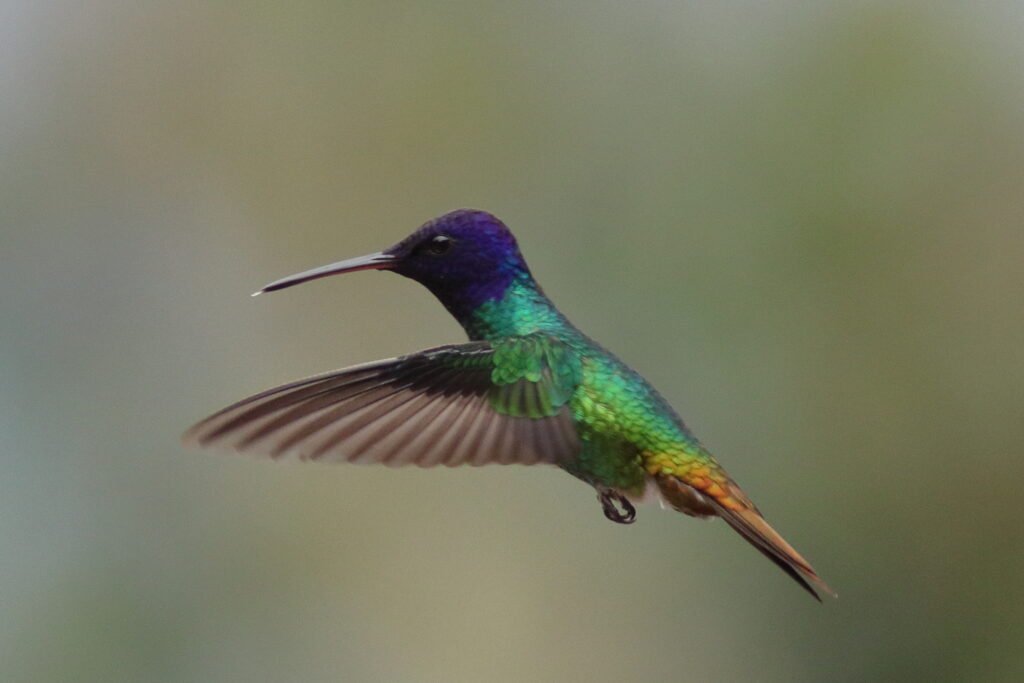
Golden-tailed Sapphire – A stunning bird found east of the mountains; we would only see it at the WildSumaco Lodge. We stayed at this location on the higher slopes of the Amazonian drainage.
Gould’s Jewelfront – This bird is common in the Amazon region. Our tour barely touched the Amazon Highlands. We were lucky to find a single individual at the WildSumaco Lodge.


Tyrian Metaltail – While not technically a jewel by name, it is a jewel in its own right. This lovely bird is commonly found in the high elevations on both sides of the Andes: Zuro Loma Preserve at 9,100 feet, Tambo Condor Lodge at 11,100 feet and Guango Lodge at 8,800 feet in the Amazon highlands.
Some hummingbirds get their name from a physical characteristic. Some examples include:
Brown Violetear – The Brown Violetear stands out for two reasons. One it is so plain with only the violet around the ears and the hard to see throat sparkles as the only bright colors. Second because they dominate a bird feeder, chasing all other hummingbirds away. All the Violet-ear’s have a threat display that include flapping out those purple feathers to make their head very large and threatening. It works.

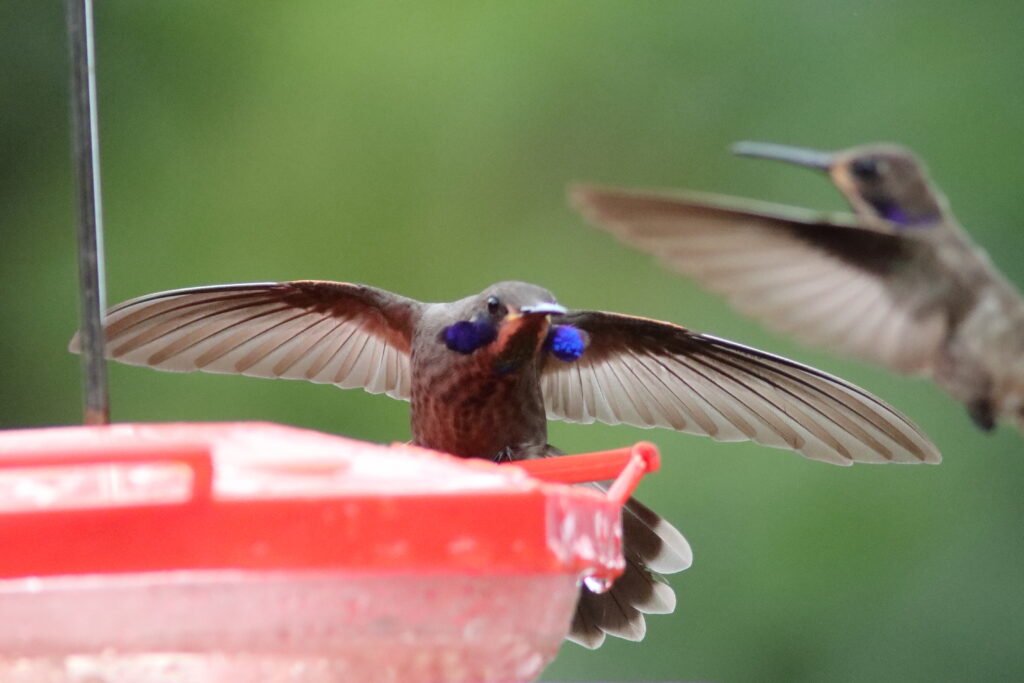
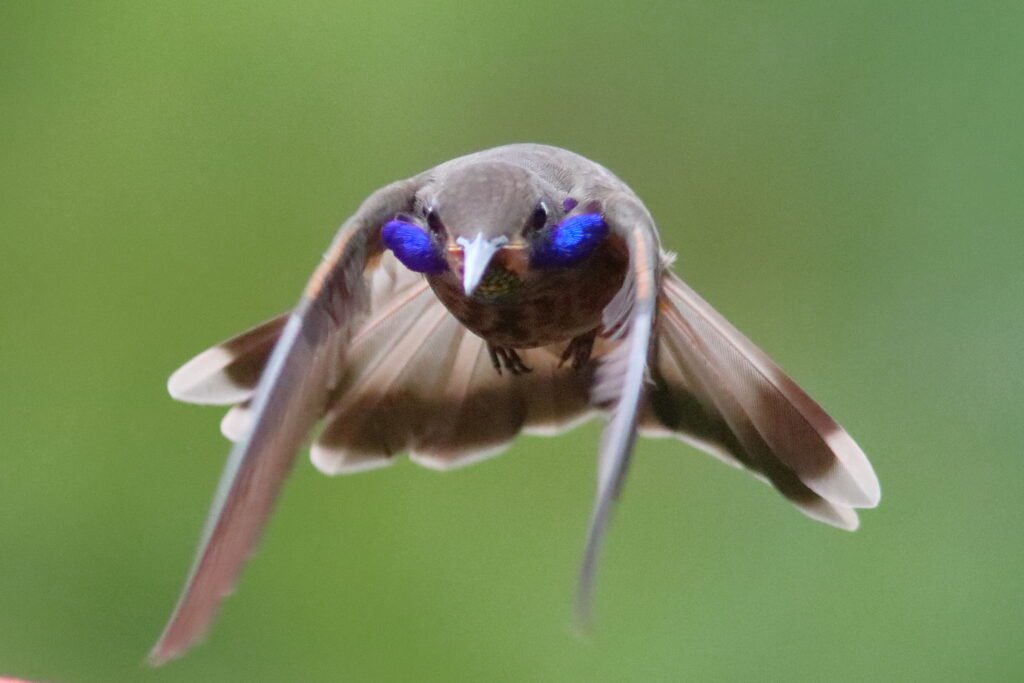
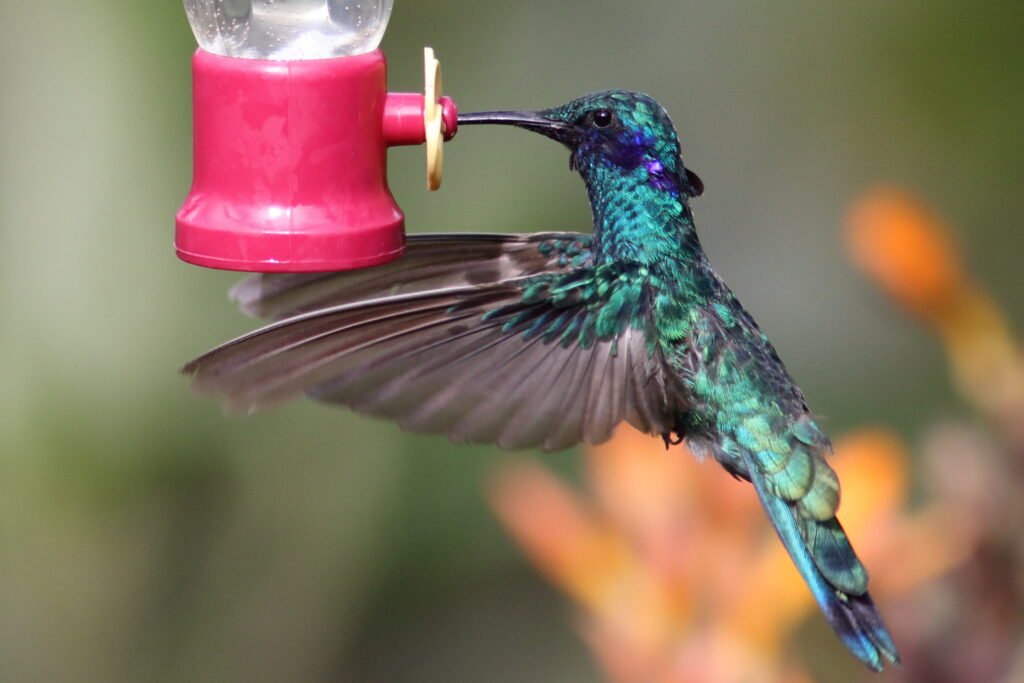
Sparkling Violetear – Probably the most common hummingbird we found, they were at 6 different locations in Ecuador and 2 places in Peru. The Hotel San Jose de Las Puembo provided many opportunities to observe these birds as they fed in the bushes right in front of our room. These birds can be found from 5,100 to 15,500 FASL.
Lesser Violetear – This doppelganger of the Sparkling Violetear likes lower elevations (3,600 to 6,900 FASL) and is a smaller bird. Their location helps with identification most of the time. Like all of the other violetears, this has those violet feathers it can flair out when disturbed.
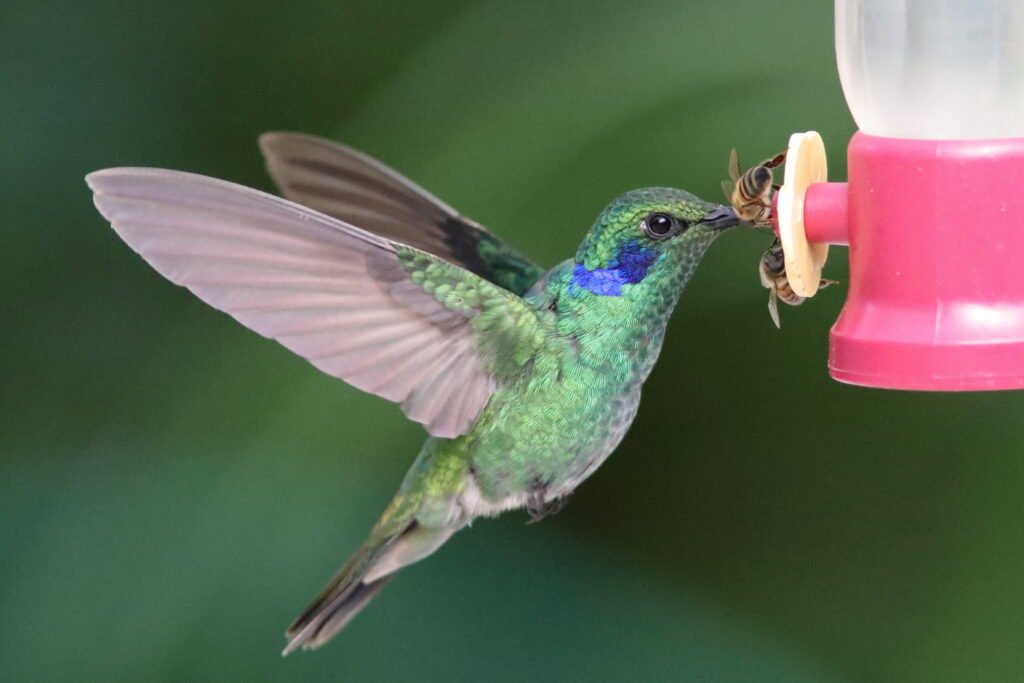
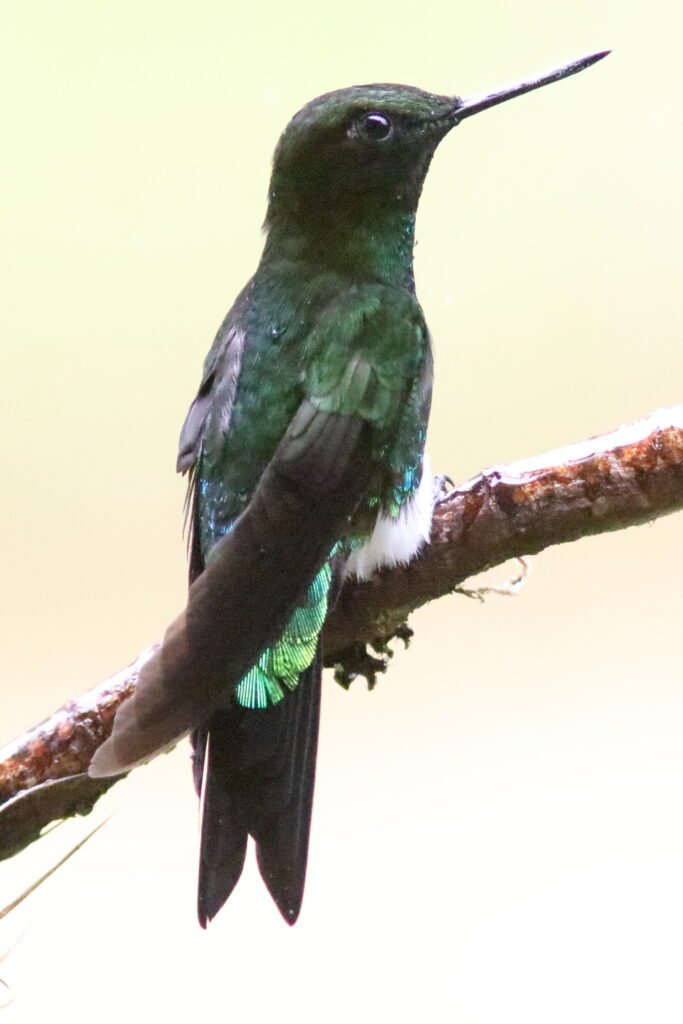
Glowing Puffleg – A high elevation hummingbird they can be found mostly from 8.400 to 10.500 FASL. We only found this single bird at the Guango Lodge. The short bill and white fluffy boots help identify this species.
Peruvian Racket-tail – A small hummingbird, it makes up for its size with those long tails. My niece, when she saw a picture of one said, “I want those boots!” We found these exclusively on the east side of the mountains.


White-booted Racket-tail – The west side of the mountains contained this species making its location and its white boots easy to separate from the previous species. We would see numerous individuals of both species at the locations where they were present.
Wire-crested Thorntail – A very unique looking hummingbird, we only found them once on the east side. They apparently are not often found at feeders, preferring to feed high up in the trees.


Green Thorntail – This poorly known hummingbird does migrate but the migration goes from high altitude (1,200 to 1,600 FASL) to low altitude (as low as 180 FASL). In Ecuador it can be found on the west slope of the mountains.
Mountain Velvetbreast – The Mountain Velvetbreast’s name fits this high-altitude hummingbird well. They can be found between 6,000 FASL and 10,200 FASL.
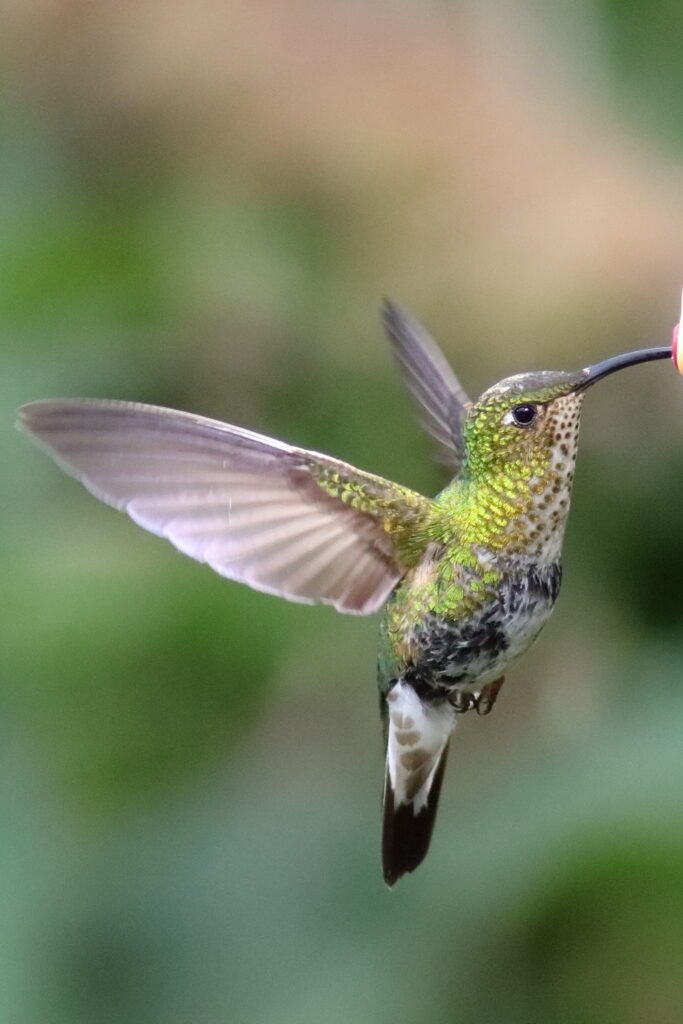

Purple-bibbed Whitetip – Recognized by the bright white patch on the tail, this species lives in a very thin zone between 3,600 and 4,200 FASL.
Some of my favorites were named after sprites – nymphs, sylphs, and fairies.
Crowned Woodnymph – A bird that can commonly be found through Central America into northern South America, scientists define 7 subspecies based upon physical characteristics. The male birds have a purple crown and the female a bright green crown.

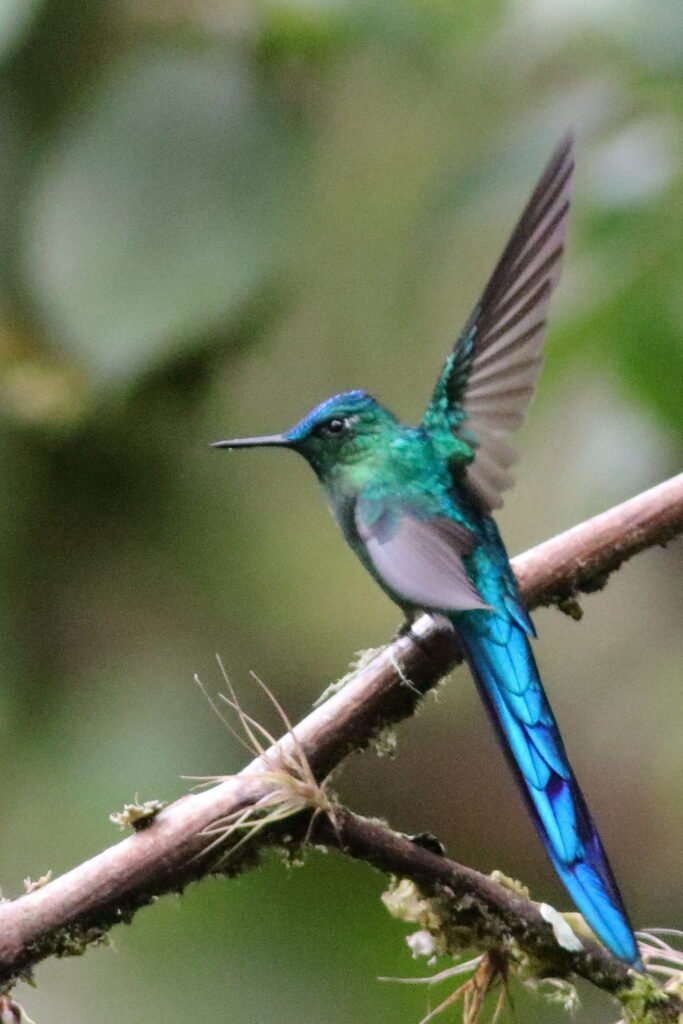
Long-tailed Sylph – The two species of sylphs we found are far from “imaginary spirits of the air.” The male sports a long brilliantly colored tail that looks very different from the female. We found them on the east side of the Andes. This is another species with a relatively small elevational range – 1,800 to 2,700 FASL.
Violet-tailed Sylph – Looking very similar to the Long-tailed Sylph, these birds are only found on the west side of the Andes between 3,000 (where they are most often found) and 6,000 FASL. Like so many birds in Ecuador, their range map is a thin line scribed across the mountain face.

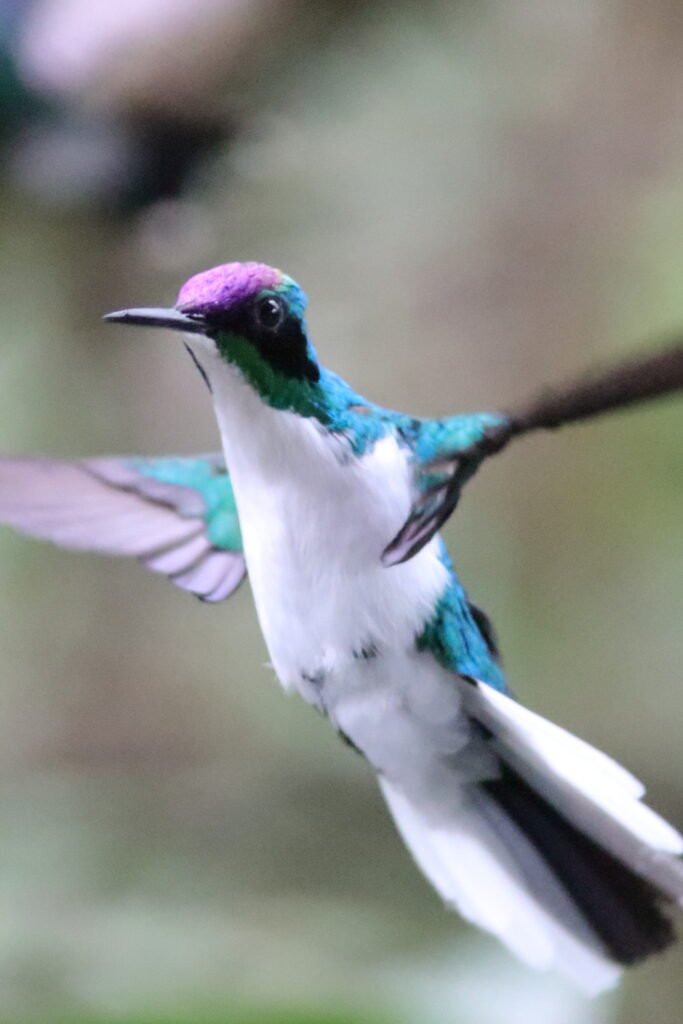
Purple-crowned Fairy – I’ve seen these lovely birds in Costa Rica, Panama, and Ecuador, where the population peters out. This mid-sized long-tailed hummingbird that drifts in to feed on flowers and feeders looks like a fairy. Because its bill is very short, they will often feed by sipping nectar from a slit at the base of the flower thus circumventing the pollination services usually performed by hummingbirds. We would only find this bird once as a single individual.
Then there are the birds connected to the sky.
Shining Sunbeam – What a name! This hefty, glistening gold hummingbird lives in high elevations (7,500 to 13,500 FASL) only in the ecological zones known as the sub páramo and the páramo. The páramo is high above the tree line.

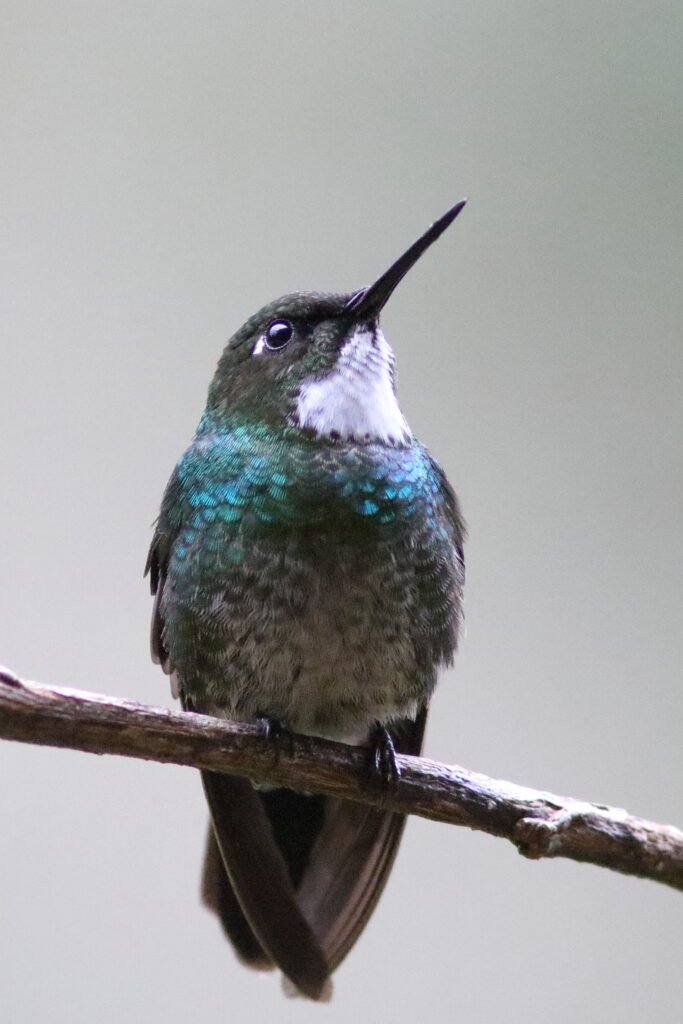
Tourmaline Sunangel – I could have put this in with the jewels, but it is the group name–Sunangel– that fits here. The mineral tourmaline comes in a variety of colors. The most popular variety is called the Watermelon Tourmaline. My image is of a female with her white throat. The male’s chin is a violet-blue and its throat a brilliant magenta. Someone had an imagination when naming this species.
Gorgeted Sunangel – Almost an Ecuadorian endemic, the population of the Gorgeted Sunangel does extend just into Columbia. Like many of the hummingbirds it is an elevation specialist (3,600 to 8,400 FASL). We would only find this species in one location and I was lucky enough to capture this image of a male. For those who don’t know, the gorget is the bright throat on many hummingbirds.
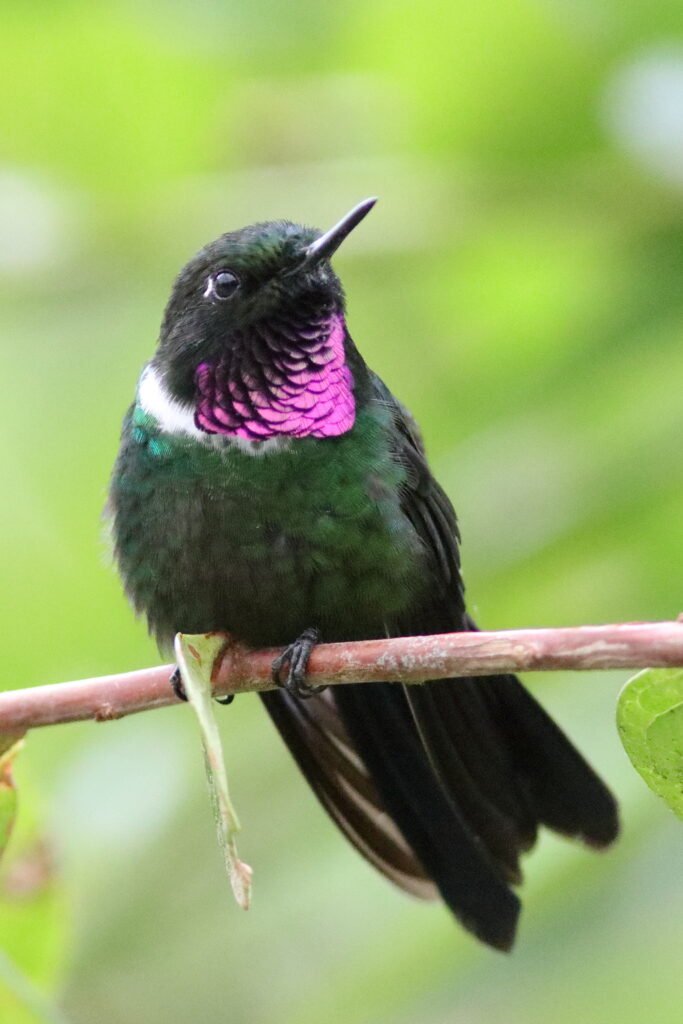
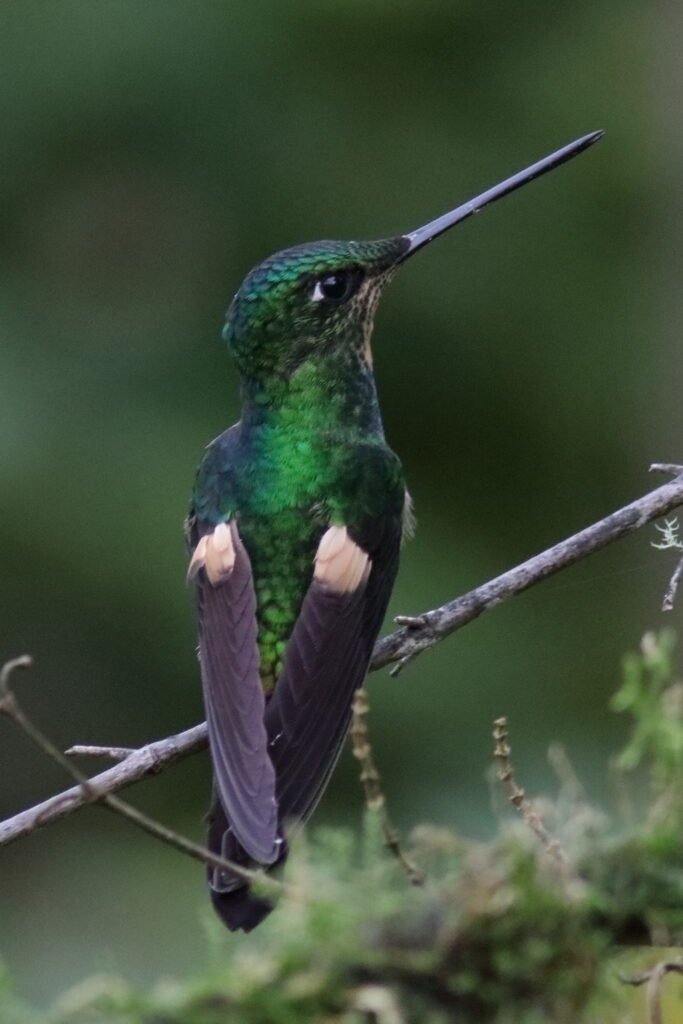
Buff-winged Starfrontlet – We would find two species of Starfrontlets, though I only got a picture of this bird. Another one of the high elevation species, the Buff-winged Starfrontlet can most commonly be found around 9,000 FASL.
Rufous-gaped Hillstar – We only found this species in one location and just this single individual. A relatively plain bird one needs to see the small rufous color at the base of the bill to be certain of the identification. They are only found in the NW corner and on the west side of the mountains between 4,800 and 5,400 FASL.
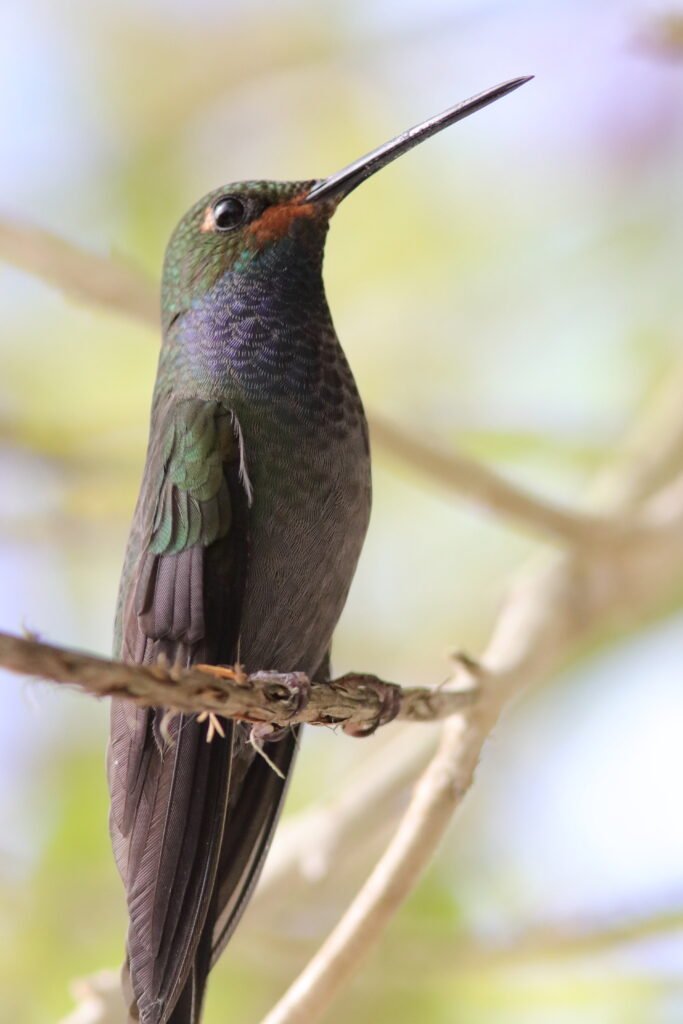

Green-backed Hillstar – Found only on the west side of the mountains at a similar altitude as the previous species, we would only find this species at the La Brisa Hummingbird Feeders.
White-bellied Woodstar – The woodstars are all small and fly more like a bumble bee than a hummingbird. One hypothesis is this allows them to sneak in and feed around the larger aggressive hummingbirds. We found this in numerous locations starting at our hotel in Quito, extending to the high altitudes of Zuro Loma and the lower eastern altitudes of Guango Lodge.


Gorgeted Woodstar – This may be the smallest hummingbird we found clocking in at just 2.5 inches. Sexually dimorphic, the breeding plumage male sports a bright magenta throat bordered by a white band over a green belly. The female breast is rufous. Being so small, they just dash in and out to feed as the larger hummingbirds frequently chase them.
Purple-throated Woodstar – Another tiny hummingbird. This species is found on the west side of the mountains as opposed to the Gorgeted Woodstar which is on the east. Like the previous bird, the woodstars are sexually dimorphic. I was able to get images of both the male and the female. In this image, he has his nictitating membrane crossing is eye. This membrane, often called the third eyelid and not seen very often, both protects and moistens the eyes of birds and other animals that have them.

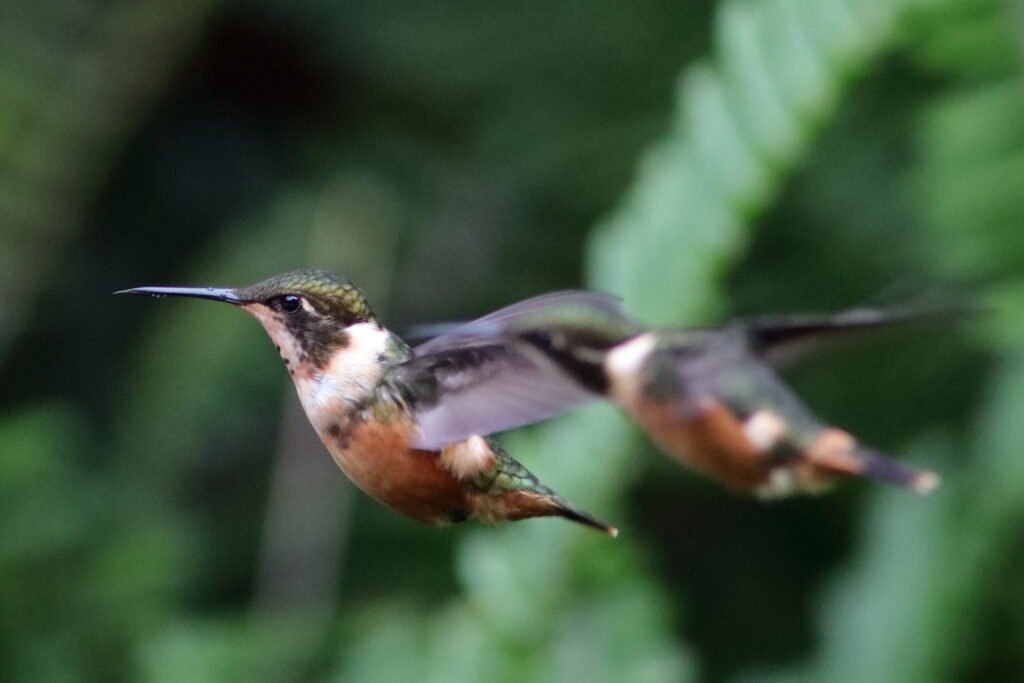
Female Purple-throated Woodstar
Some of the hummingbirds are named after people, personalities, or jobs.
Black-tailed Trainbearer – This male bird needs someone to carry his train. Probably the first hummingbird we found in Ecuador, we would see it regularly at the flowering shrubs in the hotel and nowhere else until we went to Peru. They like the high elevation and the openness of the suburbs we stayed in. A fully decked out male has a length of about 8 inches with the tail being 6 inches of that.
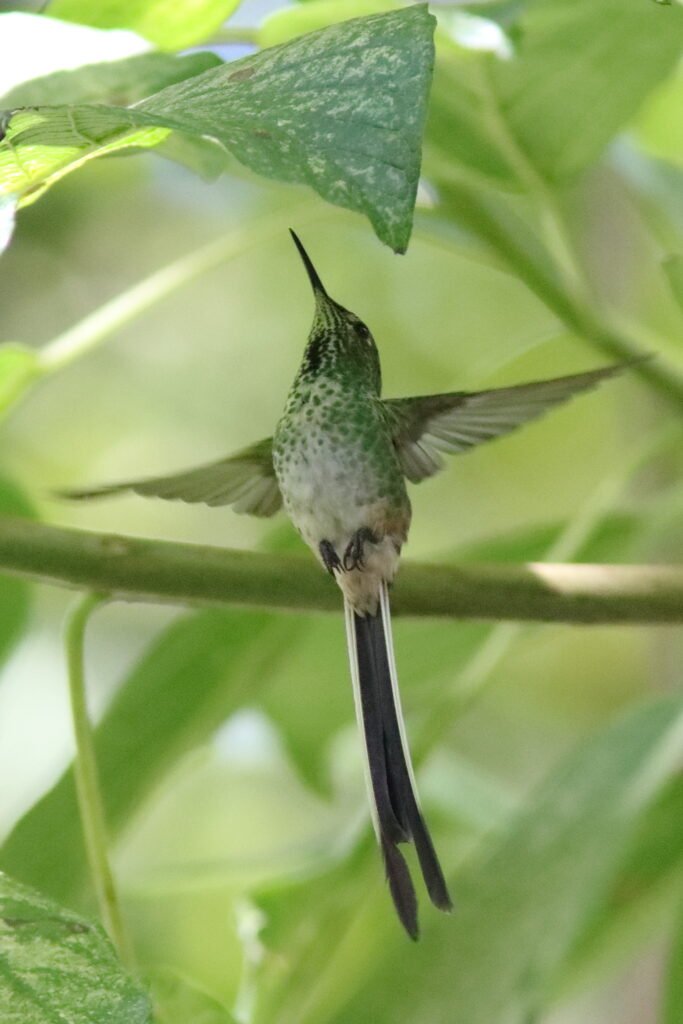

Green-tailed Trainbearer – Like the previous species, we found this in the high elevation of the hotel in Quito, but we also found it in the high elevation of Zuro Loma Preserve. As well as in Peru. A bird about 6 inches long, the tail makes up 4 inches of that length.
Bronzy Hermit – Since we spent most of our time traveling from the foothills of the west Andes to the foothills of the east Andes, we only found this low altitude hummingbird (sea level to 2,400 FASL) once. The hermits all sport decurved bills specially designed to feed on Heliconia flowers.
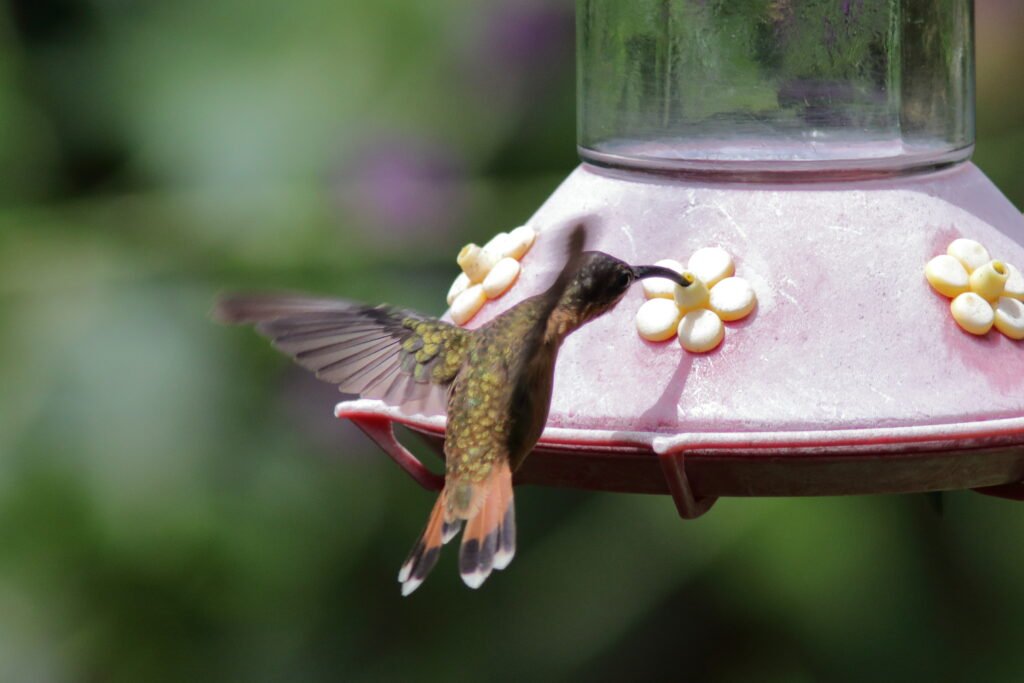
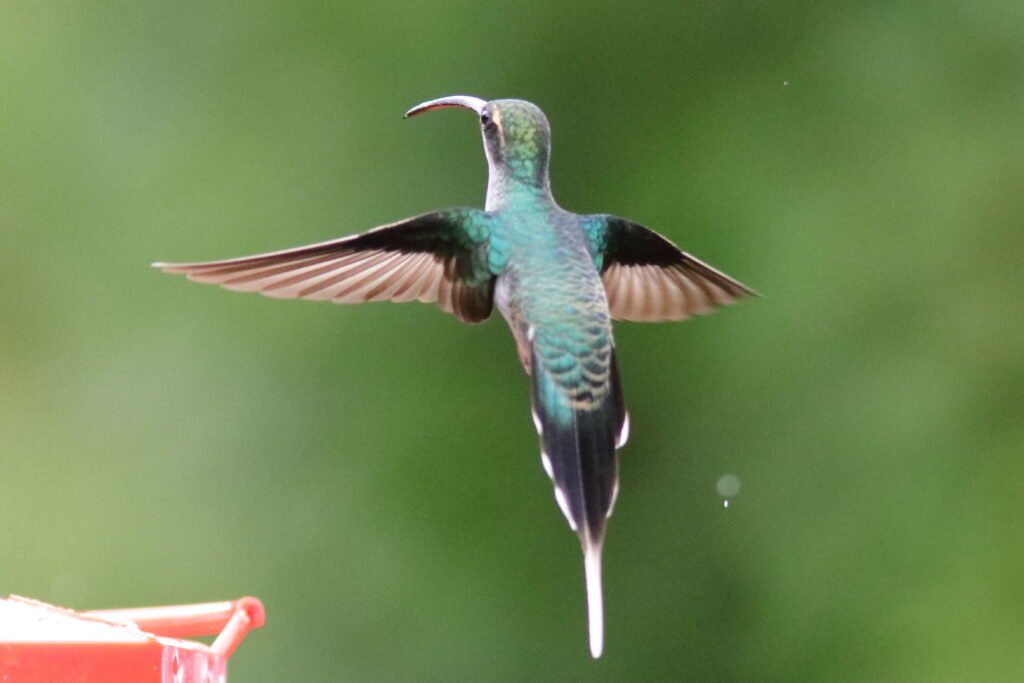
Green Hermit – Found only between 2,700 and 5,400 FASL and only on the east side of the Andes, this long bird with white tail feathers and curved bill can’t be confused with anything else. This hermit, like many of the hermits, uses leks when breeding. At this time, they are far from being a hermit as multiple males choose an area and noisily display for any female that wanders near. Usually, one male proves to be the most appealing and the most successful breeder.
White-whiskered Hermit – This fairly common bird restricted to the west side of the mountains, mostly below 3,600 FASL, is surprisingly understudied. Scientists still have not identified its breeding season. We would see them in good numbers at four separate locations. There is still much to learn about birds!
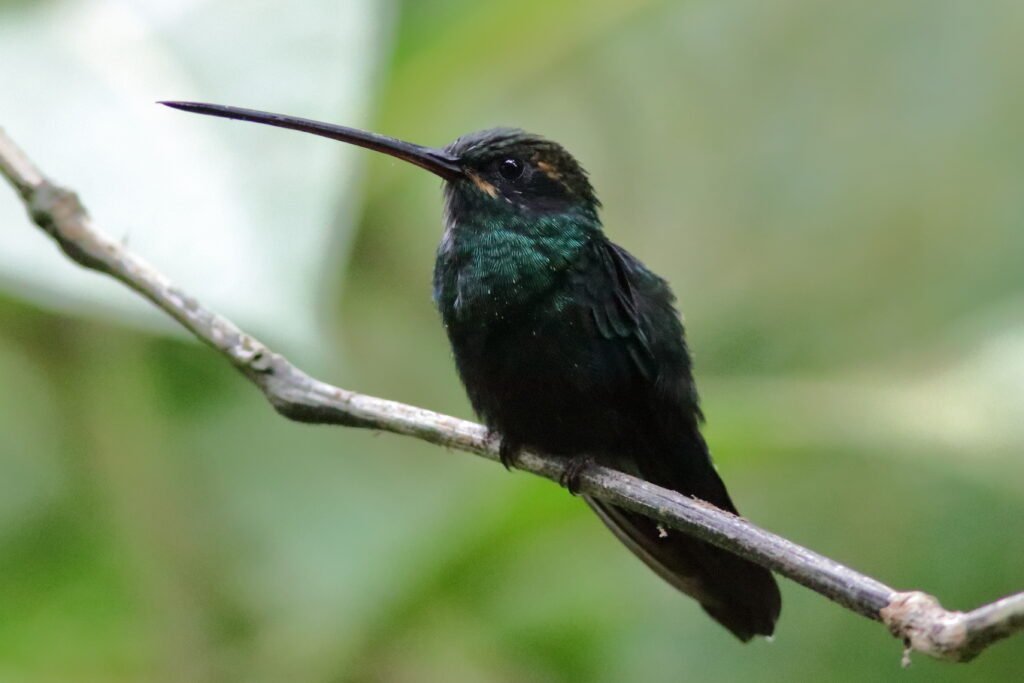
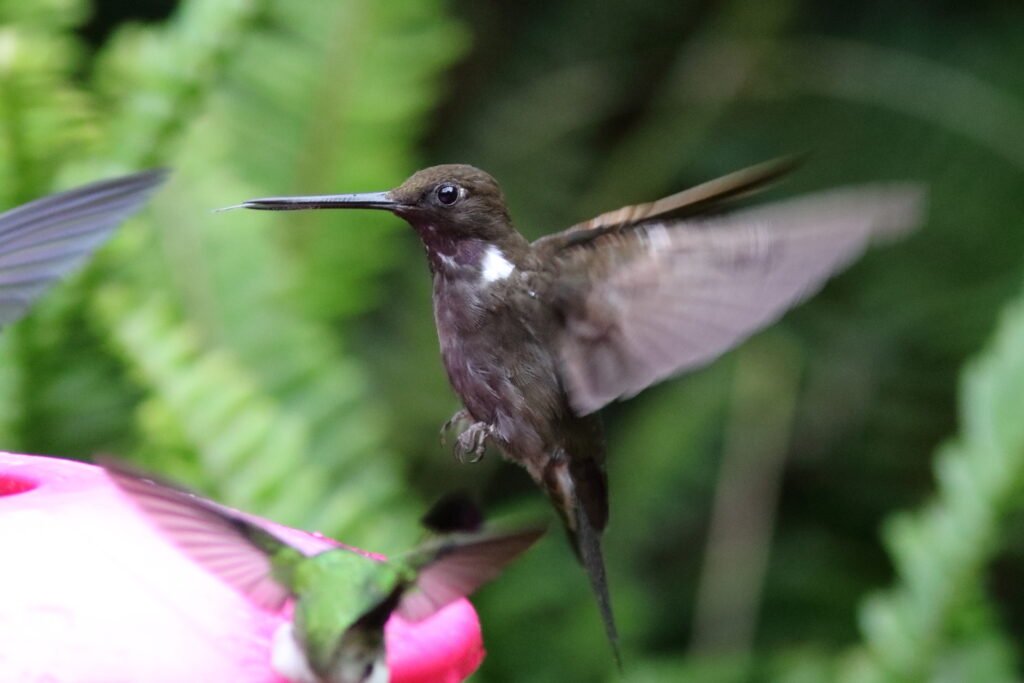
Brown Inca – Talk about a restricted range. This plain brown hummingbird can only be found between the elevations of 3,000 and 3,900 FASL. Their range map is a thin line slicing through the western mountains of Columbia and Ecuador.
Collared Inca – A large and fast hummingbird with bold white tail feathers, the Collared Inca has a very long straight bill. The male (as in this picture) has a little purple at the nape of its neck. The female’ nape is green. I was unable to capture an image of the Bronzy Inca, but the Collared Inca likes it in higher elevations 5,400 to 9,000 FASL. The Bronzy Inca is below that and the Brown Inca is lower than the Bronzy. The three inca hardly ever are found in the same area.


White-necked Jacobin – A very common hummingbird found mostly on the east side of the mountain ranges that extend from central Mexico to Brazil and Peru and Bolivia, they have s small portion of their range along the western lowlands of Ecuador. This is where we would find our birds. Several years ago while in Panama a number of us from Seabrook Island enjoyed feeding these birds by hand. They love feeders and can be quite aggressive.
Black-throated Mango – I snuck this in here at the end because it really does not fit into any of the categories. Another of the sexually dimorphic hummingbirds, the female looks much different from the male in this image. Her breast is white with a black streak down the middle. This makes her much easier to identify than the male. Another very common hummingbird throughout Panama and eastern South America, we found ours in the disjunct population in the western lowlands of Ecuador.
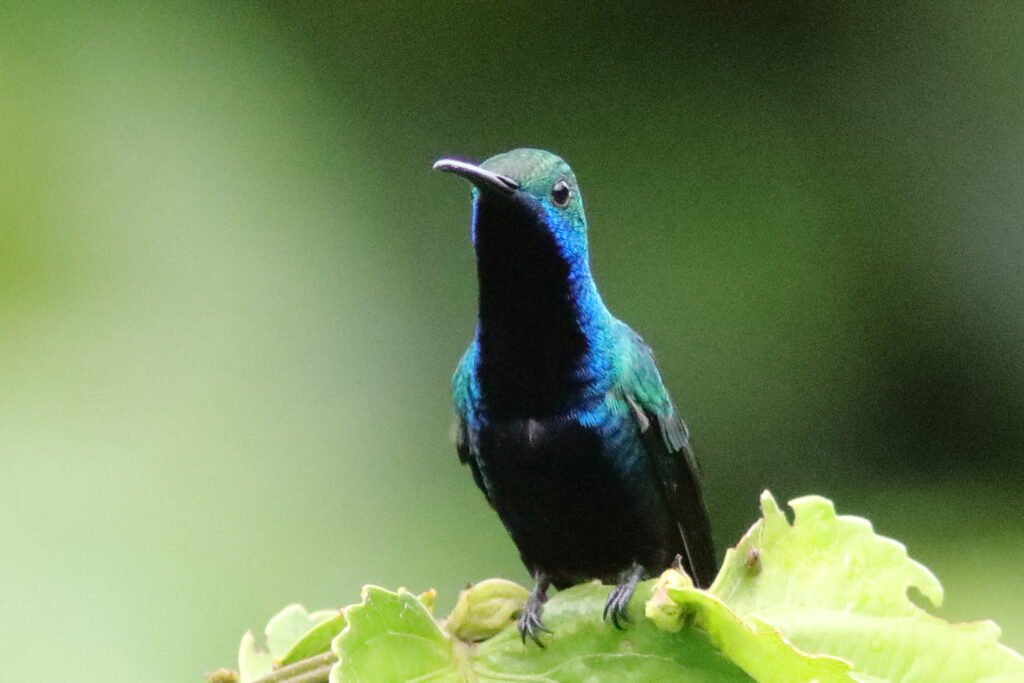
That is a lot of birds, and I applaud anyone who made it all the way through! You must love birds! Thank you for reading my blog. I hope you enjoyed it!
References
Hummingbird numbers and species – https://www.hummingbirdcentral.com/hummingbirds-of-ecuador.htm
Elevation preferences were garnered from the individual bird records on Cornell University’s Birds of the World website.
Written by Bob Mercer
Photos by Bob Mercer

